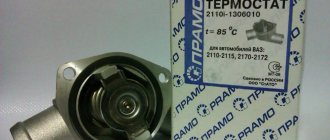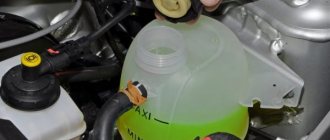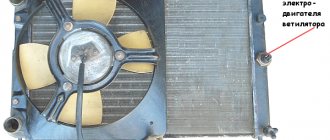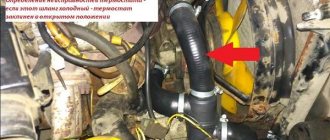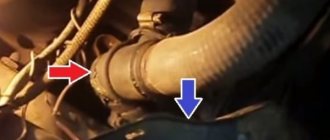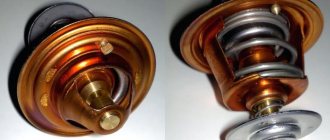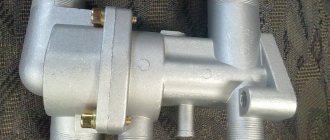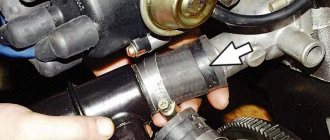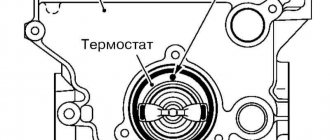The thermostat is designed to redirect the flow of antifreeze when the engine reaches a certain temperature. The design of the regulator is such that from the moment the engine is started until it warms up to 90°C, the antifreeze circulates through a small circuit.
After 90°C, the thermostat opens the valve and redirects the antifreeze in a large circle through the system radiator to release excess heat.
Appearance of the new spare part
During operation, various malfunctions and breakdowns occur due to defects, deposits, and rust. Like any other unit, the regulator requires constant preventative maintenance and diagnostics.
Let's look at how to service the thermostat yourself using the example of a Lada Granta car.
Removing and checking the thermostat
If the thermostat is working properly, after starting a cold engine, the lower hose leading from the radiator should remain cold for some time, and then (after the coolant temperature exceeds 85 ± 2 °C) quickly heat up, which indicates the start of coolant circulation in a large circle.
To dismantle the thermostat, remove the air supply hose to the throttle assembly (see “Removing the air supply hose to the throttle assembly”) and the air filter (see “Removing the air filter and air intake”). Drain the liquid from the cooling system (see “Replacing the coolant”). Having released the clamp of the engine control system wiring harness block, disconnect the block from the coolant temperature sensor connector. Using a 13 mm wrench, unscrew the nut securing the tip of the “mass” wire to the thermostat housing...
...remove the wire end from the stud.
Using the “8” head, loosen the tightening of the clamp securing the radiator supply hose...
...and remove the hose from the thermostat housing pipe.
Similarly, disconnect the fluid supply hose to the heater radiator from the thermostat cover pipe.
Using a 13mm socket, unscrew the two nuts securing the thermostat housing and remove the housing from the cylinder head studs.
The connection between the thermostat housing and the cylinder head is sealed with a gasket.
Using a Torx T‑30 wrench, unscrew the three screws securing the thermostat cover (shown with the coolant temperature sensor removed).…
...and remove the cover.
The connection between the cover and the thermostat body is sealed with a rubber ring.
Overcoming the force of the spring, we press the jaws of the pliers onto the fixing plate.
By turning the plate in any direction, we disengage it from the protrusions of the thermostat housing.
...and the thermostat spring.
We take out the thermostat bottle. To check the thermostat, lower its container into a transparent container with coolant. We heat the vessel, simultaneously stirring the liquid and monitoring the beginning of movement of the cylinder rod with a thermometer. For a working thermostat, the cylinder rod should begin to extend at a temperature of 85±2 °C. At a liquid temperature of 100±2 °C, the cylinder rod must extend completely - the rod stroke is at least 8 mm. We assemble and install the thermostat in the reverse order. When installing the cylinder, its rod must enter...
...into the housing hole. We replace the sealing ring of the thermostat cover and the gasket at the connection of the housing with the cylinder head with new ones. Before installation, we clean the mating surfaces of the cylinder head from remnants of the old gasket...
Car : Lada Granta. Asks : Shmakov Viktor. The essence of the question : At what temperature does the thermostat on the Lada Granta open?
Please tell me at what temperature the thermostat on the Lada Granta should open, with the settings that were installed on it from the factory?
Owner reviews
| № | Positive |
| 1. | Gennady: 65,000 km, no comments on the cooling system elements. For my part, I try to systematically carry out technical inspections and fill in high-quality antifreeze. |
| 2. | Vladimir: at 75,000 km I replaced the “regulator” for the first time, I think that for a domestic car the service life is more than good. |
| 3. | Alexander: During the two years of operation of the machine, breakdowns occurred, but there were no large-scale ones. I eliminated the unimportant ones on my own. Of course, “our” manufacturer is far from perfect, but the quality is an order of magnitude higher than previous modifications. |
| 4. | Sergey: The stove heater in Grant heats very well, it’s hot, I often open the windows for ventilation. I don't remember early models having this quality. |
| 5. | Vasily: I’m pleased with the build quality of the domestic car; there are some faults, but they can be easily fixed on your own. |
| 6. | Gennady: after buying the car, I immediately drained the “native” antifreeze and filled it with high-quality imported one. The cooling system works like a clock. |
| 7. | Dmitry: I’m happy with the car, the units are working as normal. I follow the maintenance schedule and buy original parts. |
| Negative | |
| 1. | Kirill: I drove 35,000 km without any breakdowns, and then the car started to fall apart. In a year and a half, I have already visited a service station twice unscheduled for diagnostics. |
| 2. | Stepan: I regretted that I bought Grant, the model is crude, there are many flaws and defects. The manufacturer is in no hurry to fix it. |
| 3. | Victor: don’t rush to buy Grant; Renault Logan can be used as a good alternative. |
Properly assembled thermocouple
Conclusion
As standard, the Lada Granta is equipped with parts from a domestic manufacturer. The average service life of heating system elements is 75 – 80 thousand km.
As an alternative to domestic elements (21082), owners purchase foreign analogues, such as Wahler, Stellox. The service life is 10–15% longer, but the price is an order of magnitude higher. It's worth thinking a few times before buying.
| Video - Replacing the grant thermoelement |
| Video - Lada Granta thermostat thermocouple or why the car takes a long time to heat up and cools down quickly |
| < |
Thermostat opening and closing temperatures on Grant
The thermostat has two valves: main and additional. At a fluid temperature of up to 85 °C , the thermostat is tightly closed, and it circulates in a small circle, bypassing the radiator, which helps to warm up the engine as quickly as possible. As soon as the temperature rises from 86° C , the thermostat begins to gradually open and at a coolant temperature of 102° C , it opens completely, ensuring its passage in a full circle through the radiator.
Thus, it becomes clear that the thermostat starts working already from 86 °C.
Video review of the factory thermostat
About the nuances of installation
You may be interested in: Ford computer diagnostics: complete vehicle check
The device is mounted at the top of the engine in the area where the coolant exits into the radiator unit. It helps to quickly warm up the vehicle, holding back cooling until the engine reaches an elevated temperature. The essence of the device lies in three elements: a cylinder, a pin, and wax. A scheme of this state has been used for a long time, without undergoing any special modernization, including in new brands of cars. As a result, engine parts do not wear out prematurely, and their dynamic performance improves.
What is a thermostat (functions, operating principle)
Thermostat location under the hood
The thermostat, equipped with a solid heat-sensitive filler installed on Lada Granta cars, is designed to maintain the optimal operating temperature of the engine coolant, as well as to reduce its warm-up time.
To cool the power plant, every car these days uses specialized coolants, which makes it possible to additionally organize heating of the car interior during the cold season.
Reliable operation of this system is ensured by special devices - thermostats. Their main function is to create conditions for rapid heating of the engine and maintaining it in the required operating conditions.
general information
There are single-valve, two-stage and two-valve thermostats, as well as electronically controlled devices. Grants are equipped with thermostats Luzar LT0191 and Luzar LT0190 (costing from 450 rubles for the first, and from 800 rubles for the second), FENOX TS034E7 (costing from 800 rubles), VAZ-2123 (article 2123-1306010, cost from 650 rub.). It is worth mentioning such devices as VAZ-2101 GATES (article TH14580, cost - from 350 rubles), VAZ-2121 GATES (article TH15380, approximate cost - from 500 rubles), VAZ-2110 (article 21082-1306010, cost - from 600 rub.) and other devices. They are located between the engine and the radiator, but it should be noted that there are differences in the location of the thermostats on Grants with eight-valve and sixteen-valve engines.
Their main task is to prevent the movement of antifreeze through the radiator until the car engine warms up to the required temperatures. Accordingly, if the car engine does not warm up, then the coolant does not move in a large circle. Usually the thermostat is activated when the engine reaches a temperature of 80-95C. Among other things, the thermostat helps reduce the amount of harmful emissions released into the atmosphere and minimize engine wear.
The thermoelement located inside the device is made of brass, has a cylindrical shape and is filled with artificial wax. When the engine reaches a temperature of approximately 82C, this substance begins to melt, which causes it to expand. This sets the valve in motion, it opens, after which the antifreeze begins to circulate through the car’s radiator. Turning off the motor causes the wax to solidify inside the thermostat and close the damper.
A little about operation
You may be interested in: Car body welding: types, description, technology
The make of the car dictates the type of thermostat used. They can all be configured differently. Therefore, among the characteristics, the most important thing is what thermostat opening temperature is determined by the manufacturer.
The brand of the device is indicated on its body. It can be installed not only in the motor block, but also in a specially designated place for it. The operation of the valve is based on the melting of wax placed in a cylinder-shaped hole towards the power section. Depending on the brand, the opening temperature of the thermostat valve may vary.
In the design, the temperature parameter reaches 80 degrees, the wax expands its area, squeezing out the cylinder locking pin. The result is the unlocking of the system and the action of the coolant.
Signs of breakdown
The thermostat is a fairly simple element, however, and it is not immune to breakdowns. Normally, after starting a cold engine, the lower hose extending from the radiator does not heat up for some time, but after the coolant temperature exceeds 85C (±2C), it begins to quickly heat up (provided the thermostat is in full working order). It is this aspect that will accurately indicate to the car owner the moment the coolant begins to circulate.
In cases where the valve cannot open, the coolant stops circulating and the engine begins to overheat. Overheating also causes incomplete opening of the valve. A delay in closing the valve, on the contrary, creates conditions for a longer warm-up of the engine, especially in the cold season.
As a rule, thermostat failure is caused by the following reasons:
- an unstable engine (triplication often leads to valve damage);
- wear of the rubber gasket;
- corrosion (it is the most common cause of breakdowns);
- antifreeze gets inside the thermostat;
- there is a leakage of wax from the device;
- there is mechanical damage on the valve.
Most often, a malfunction of the thermostat leads to the impossibility of further movement in the car, and therefore the faulty part must be replaced immediately.
Instructions for replacing a faulty element
Dismantling work begins with draining the coolant. Then you need to free access to the thermostat, which will require removing the air filter. You should also remove the hose that supplies air to the throttle assembly. After this, you will press the lock of the block with the wires of the motor control system and disconnect the block.
The next step is to unscrew the nut attaching the tip of the “mass” wire to the thermostat and remove it. Then the tightening on the fastening clamp of the supply hose is loosened, after which it is removed from the pipe. The hose supplying fluid to the heater radiator is also disconnected in the same way.
Next, the nuts securing the thermostat housing itself are unscrewed, after which the housing is removed. The place where the housing connects to the cylinder heads is always sealed with a gasket. Therefore, unscrew the screws that secure the thermostat cover and remove it. In addition, a rubber ring seals the place where the lid is connected to the body. By pressing the locking plate with pliers and carefully turning it in different directions, remove this element from engagement with the protruding parts of the body. Then you need to remove the thermostat spring, after which the cylinder is removed from the thermostat.
Carrying out an inspection
The process of checking the thermostat is a relatively simple procedure. To begin, the removed thermostat bottle is lowered into a transparent container into which coolant has previously been poured. Next, this container is heated, periodically stirring the coolant and monitoring with a thermometer the moment when the cylinder rod begins to move. When the coolant reaches a temperature of 85C (±2C), the rod of a fully working device will begin to extend. When the liquid in the container is heated to 100C (±2C), it will extend completely.
Replacing the thermostat from 77C to 92C
Many Grant owners complain about rather problematic and weak thermostats in their cars. Most of the complaints are related to the fact that the device allows access to antifreeze after the engine has warmed up to 80C. In fact, there is no malfunction in this, it’s just a feature of the operation of specific engines - they are initially configured to operate at this temperature.
Most often, such features are not taken seriously by car owners, and do not interfere with the functioning of the engine. Perhaps the only noticeable difference will be cooler air inside the car at sub-zero temperatures outside. However, converting the car to gas fuel will significantly complicate this situation.
ATTENTION. For some AVTOVAZ engines, a temperature of 77-80 degrees Celsius is the operating temperature. There is no need to change the thermostat as it is working properly.
In such circumstances, the element can be modified, although not recommended by the manufacturer, after which it will open at 92C. The modification will require the purchase of a new thermostat, however, replacing the entire part will not be necessary; all you need from the new thermostat is a sensor.
To carry out this work you will need:
- drive the car onto a ramp or into a pit;
- drain the antifreeze;
- remove the air duct (it will interfere with the work process);
- dismantle the thermostat (or simply remove the cover from the device without losing the seal);
- install a new thermoelement;
- press the thermocouple with a spring and a limiter.
As a result of the above manipulation, the response temperature will increase by approximately 15%.
Expert opinion
Drivers of VAZ horses are recommended to undergo timely diagnosis. Considering that the opening temperature of the thermostat in the VAZ-2110 is 80 0C, you can check its condition as follows.
- The launch should not be delayed: 7 minutes is the optimal time period. Next, open the hood and touch the lower pipe. When in good condition, the hoses should have the same temperature. A difference in the indicator indicates a problem. The main thing is to prevent air locks from appearing, which will result in overheating and the need for urgent replacement.
- When starting the engine, you need to touch the tube leading to the coolant. In normal condition, it is cold until the engine warms up to the desired condition.
- Complex diagnostic methods include dismantling the system and dipping it into a heated liquid. The “saucepan” method can only characterize the operating state of the thermostat, without identifying problems.
To determine the required thermostat parameters suitable for a particular “iron horse”, it is necessary to take into account the valve opening temperature. Therefore, it is better to go to a specialized auto store.
